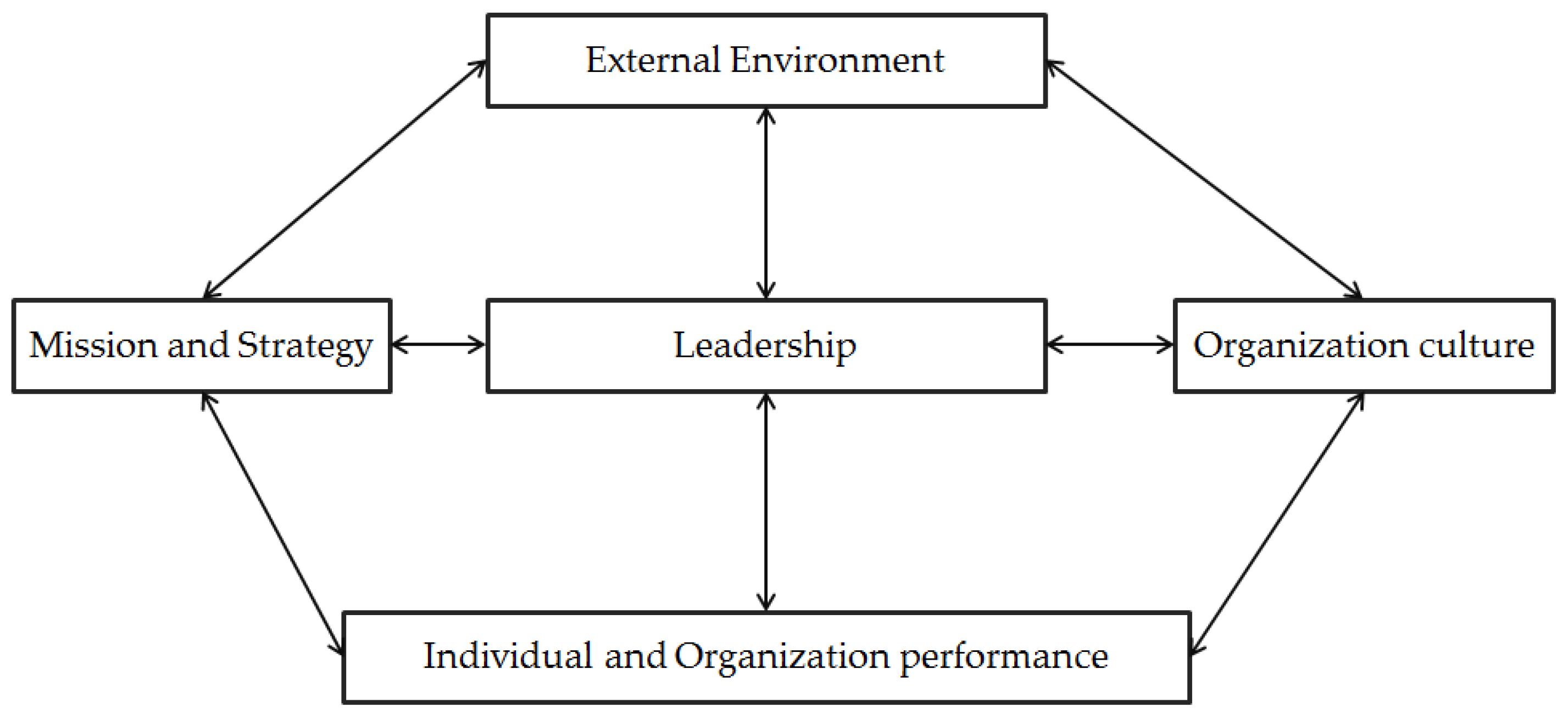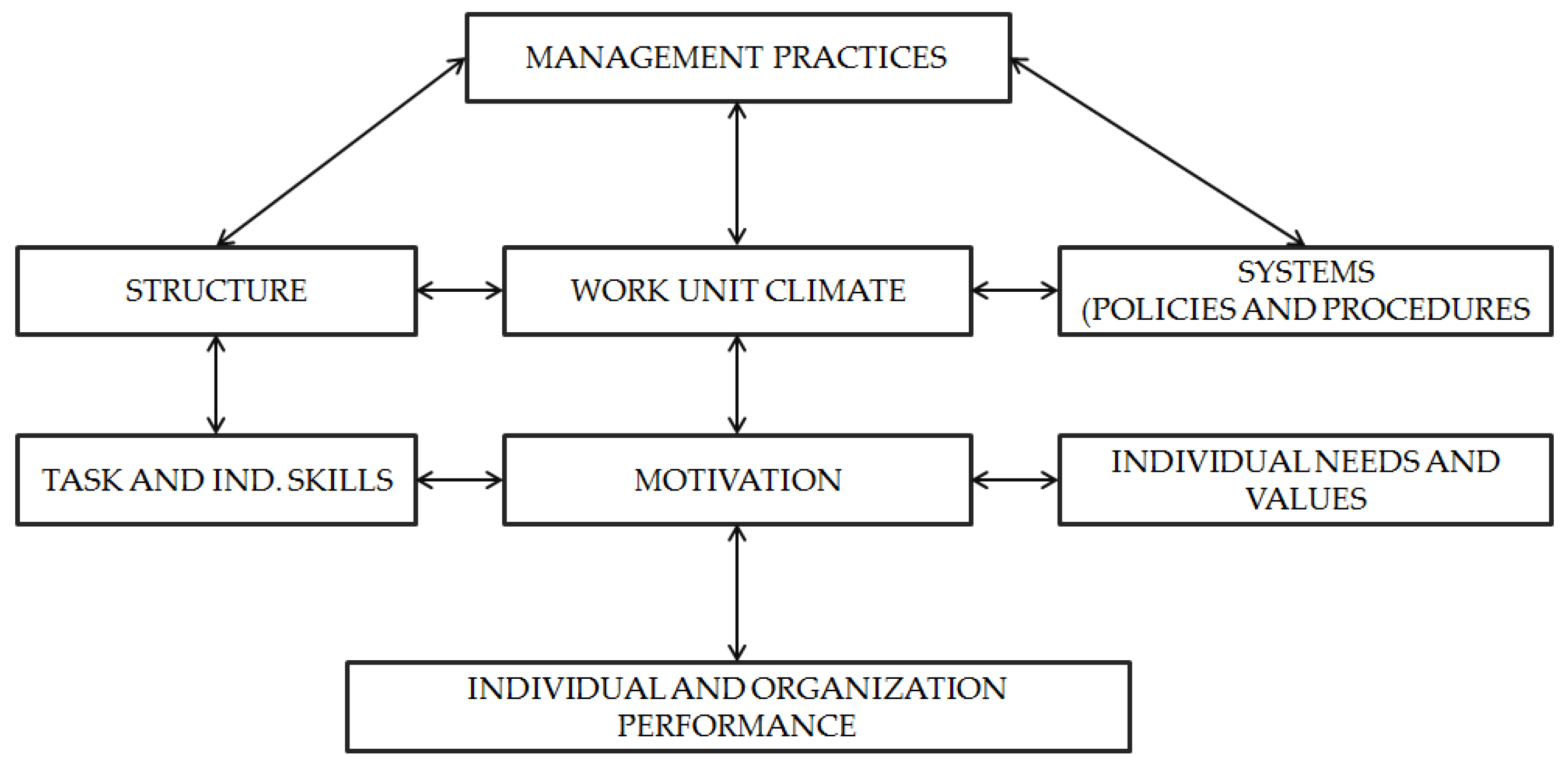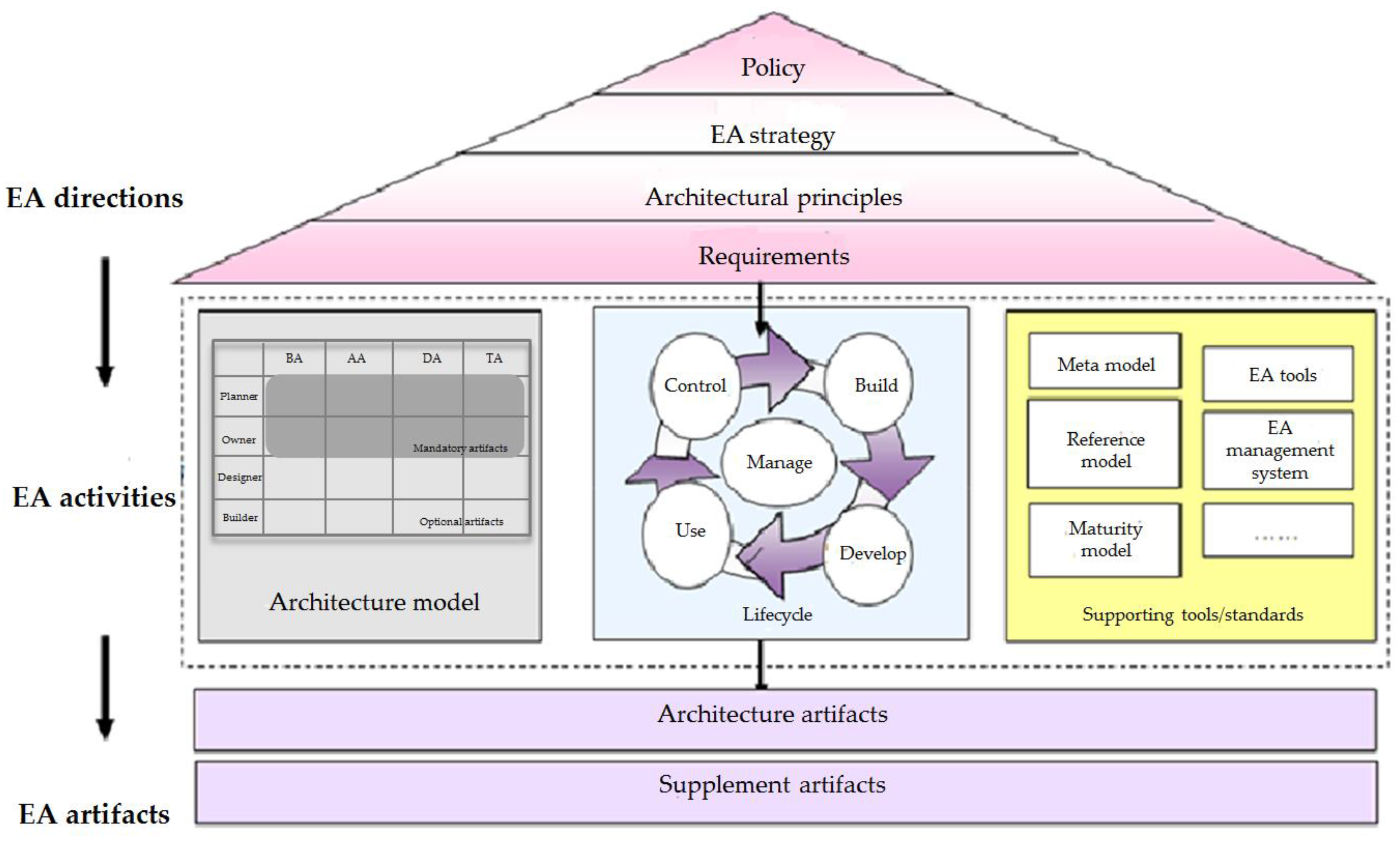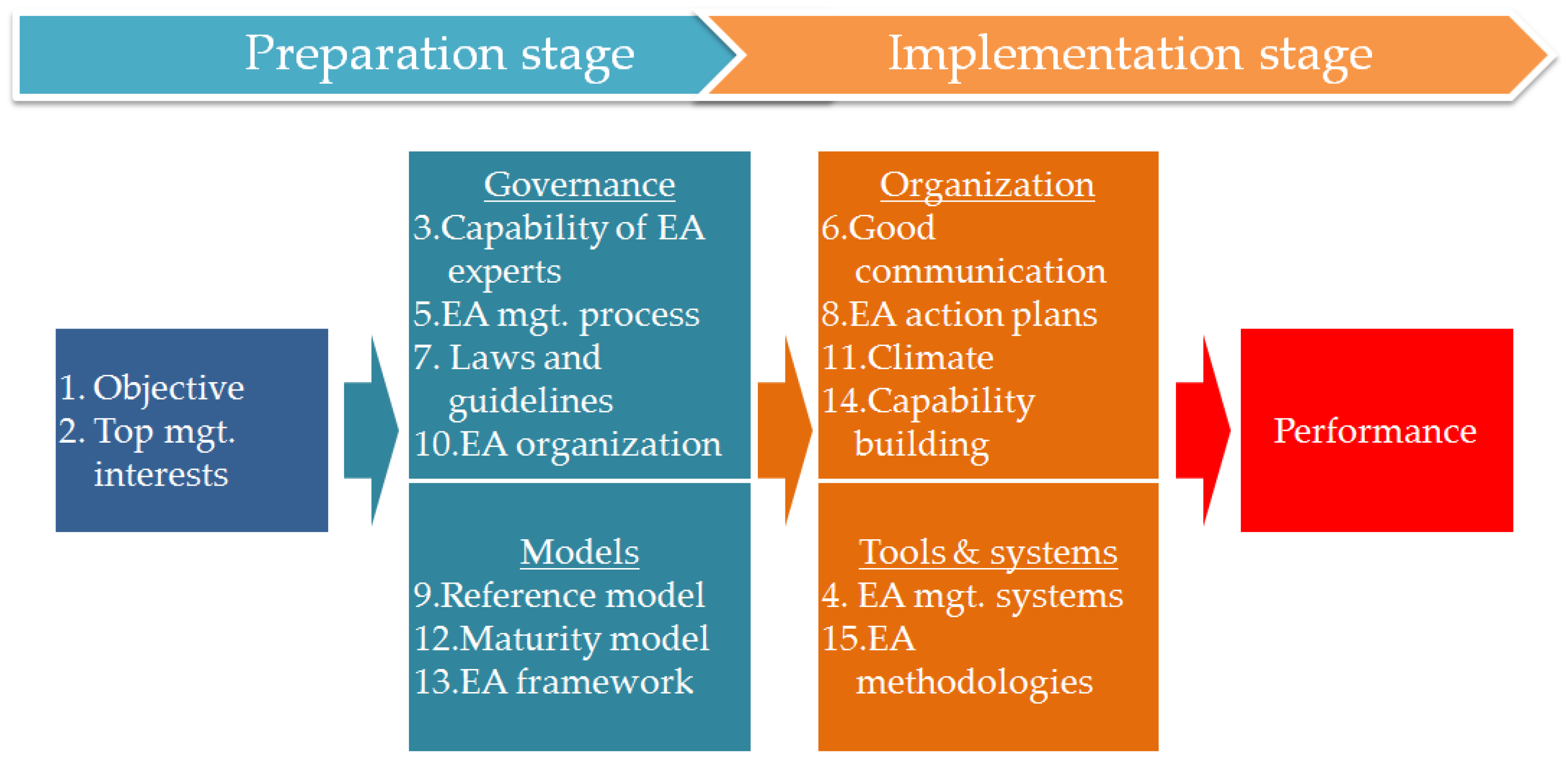Dynamics of Enterprise Architecture in the Korean Public Sector: Transformational Change vs. Transactional Change
Abstract
:1. Introduction
2. Theoretical Development
2.1. Literature Review of EA Success Factors
2.2. TFC vs. TSC
3. History of EA Development in the South Korean Public Sector
3.1. Preparation Stage
3.2. Foundation/Adoption Stage
3.3. Utilization Stage
4. Discussion
4.1. Problems of the EA Definition and EA Application Level
4.2. Survey Data from the EA Experts
4.3. EA Success Model
5. Conclusions
Author Contributions
Conflicts of Interest
References
- Kettinger, W.J.; Marchland, D.A.; Davis, J.M. Designing enterprise IT architecture to optimize flexibility and standardization in global business. MIS Q. Exec. 2010, 9, 95–113. [Google Scholar]
- Kaushik, A.; Raman, A. The new data-driven enterprise architecture for e-healthcare: Lessons from the Indian public sector. Gov. Inf. Q. 2015, 32, 63–74. [Google Scholar] [CrossRef]
- Nikpay, F.; Selamat, H.; Rouhani, B.D.; Nikfard, P. A Review of Critical Success Factors of Enterprise Architecture Implementation. In Proceedings of the 2013 International Conference of Informatics and Creative Multimedia, Kuala Lumpur, Malaysia, 4–6 September, 2013; pp. 38–42.
- Zheng, T.; Zheng, L. Examining e-government enterprise architecture research in China: A systematic approach and research agenda. Gov. Inf. Q. 2013, 30, S59–S67. [Google Scholar] [CrossRef]
- Enterprise Architecture. Available online: http://cisr.mit.edu/research/researchoverview/classic-topics /enterprise-architecture/ (accessed on 9 August 2015).
- IT Architecture Capability Maturity Model. Available online: http://ocio.os.doc.gov/s/groups/public/@doc/@os/@ocio/@oitpp/documents/content/prod01_002340.pdf (accessed on 9 August 2015).
- A Framework for Assessing and Improving Enterprise Architecture Management (Version 2.0). Available online: http://www.gao.gov/assets/80/77233.pdf (accessed on 9 August 2015).
- Zachman, J.A. A framework for information systems architecture. IBM Syst. J. 1987, 26, 276–292. [Google Scholar] [CrossRef]
- Enterprise Architecture Maturity Model, Version 1.3. Available online: http://www.nascio.org/Portals/0/Publications/Documents/2003/NASCIO-EAMM.pdf (accessed on 9 August 2015).
- Federal Enterprise Architecture Framework Version 2. Available online: https://www.whitehouse.gov/sites/default/files/omb/assets/egov_docs/fea_v2.pdf (accessed on 20 Feburary 2016).
- The Common Approach to Federal Enterprise Architecture. Available online: https://www.whitehouse.gov/sites/default/files/omb/assets/egov_docs/common_approach_to_federal_ea.pdf (accessed on 20 Feburary 2016).
- Ylimaki, T. Potential critical success factors for enterprise architecture. J. Enterp. Archit. 2006, 2, 29–40. [Google Scholar]
- Schmidt, C.; Buxmann, P. Outcomes and success factors of enterprise IT architecture management: Empirical insight from the international financial services industry. Eur. J. Inf. Syst. 2011, 20, 168–185. [Google Scholar] [CrossRef]
- Burke, W.W.; Litwin, G.H. A causal model of organizational performance and change. J. Manag. 1992, 18, 523–545. [Google Scholar] [CrossRef]
- MOGAHA Wide Government EA has Received UN Public Service Award. Available online: http://www.MOGAHA.go.kr/frt/bbs/type010/commonSelectBoardArticle.do?bbsId=BBSMSTR_000000000008&nttId=29675 (accessed on 9 August 2015).
- E-Government Survey 2014. Available online: https://publicadministration.un.org/egovkb/en-us/Reports/UN-E-Government-Survey-2014 (accessed on 19 July 2016).
- Bernard, S.A. An Introduction to Enterprise Architecture, 3rd ed.; Author House: Bloomington, IN, USA, 2012; pp. 31–33. [Google Scholar]
- Business Case Basics and Beyond: A Primer on State Government IT Business Cases. Available online: http://www.nascio.org/Portals/0/Publications/Documents/2003/NASCIO-BusinessCasePrimer2003.pdf (accessed on 9 August 2015).
- Government Enterprise Architecture. Available online: https://www.ict.govt.nz/assets/Guidance-and-Resources/Government-Enterprise-Architecture-for-New-Zealand-v3-0.pdf (accessed on 20 Feburary 2016).
- Oman eGovernment architecture framework (OeGAF). Available online: http://www.ita.gov.om/ITAPortal/Pages/Page.aspx?NID=559&PID=1848&LID=96 (accessed on 20 Feburary 2016).
- Approach to NEA. Available online: http://www.yesser.gov.sa/en/BuildingBlocks/NATIONAL_EA/Pages/Architecture_Development_Methodology.aspx (accessed on 20 Feburary 2016).
- Gil-Garcia, J.R.; Pardo, T.A. E-government success factors: Mapping practical tools to theoretical foundations. Gov. Inf. Q. 2005, 22, 187–216. [Google Scholar] [CrossRef]
- Martin, N.; Gregor, S. Enterprise Architectures and Information Systems Alignment: Policy, research, and future implications. In Proceedings of the Australasian Conference of Information Systems, Melbourne, Australia, 4–6 December 2002.
- Rohloff, M. Integrating innovation into Enterprise Architecture Management. In Proceedings of the 10th International Conference on Wirtschaftsinformatik, Zurich, Switzerland, 16–18 February 2011.
- Bricknall, R.; Darrell, G.; Nilsson, H.; Pessi, K. Enterprise architecture: Critical factors affecting modelling and management. In Proceedings of the European Conference on Information Systems, Gothenburg, Sweden, 12–14 June 2006; pp. 2349–2361.
- Oliveira, J.; Nightingale, D. Adaptable Enterprise Architecture and Long Term Value Added Partnerships in Healthcare. In Proceedings of the European Conference on Information Systems, St Gallen, Switzerland, 7–9 June 2007; pp. 1815–1826.
- Bradley, R.; Pratt, R.; Byrd, T.A.; Simmons, L. The role of enterprise architecture in the quest for IT value. MIS Q. Exec. 2011, 10, 73–80. [Google Scholar]
- Smith, H.A.; Watson, R.T.; Sullivan, P. Delivering an effective Enterprise Architecture at Chubb Insurance. MIS Q. Exec. 2012, 11, 75–82. [Google Scholar]
- Venkatesh, V.; Bala, H.; Venkatraman, S.; Bates, J. Enterprise Architecture Maturity: The Story of the Veterans Health Administration. MIS Q. Exec. 2007, 6, 79–90. [Google Scholar]
- Susarapu, S.R.; Baker, E.W. Analyzing Enterprise Architecture Integration at the DHS Using the Zachman Framework. In Proceedings of the SAIS, Borås, Sweden, 22–23 May 2007; pp. 172–177.
- Gill, A.; Smith, S.; Beydoun, G.; Sugumaran, V. Agile Enterprise Architecture: A case of a cloud technology-enabled government enterprise transformation. In Proceedings of the Pacific Asia Conference on Information Systems, Chengdu, China, 24–28 June 2014; pp. 1–11.
- Janssen, M.; Hjort-Madsen, K. Analyzing enterprise architecture in national governance: The cases of Denmark and the Netherlands. In Proceedings of the 40th Hawaii International Conference on System Sciences, Waikoloa, Big Island, HI, USA, 3–6 January 2007.
- Lee, Y.H.; Chae, M.S. An Empirical Study on the Factors Affecting the Adoption of Enterprise Architecture based on the TOE Framework. Korean Manag. Sci. 2006, 23, 17–39. [Google Scholar]
- Hong, Y.D.; Kim, S.K. An Empirical Study on the Factors Influencing the Adoption of Enterprise Architecture. J. Inf. Technol. Appl. Manag. 2006, 14, 37–55. [Google Scholar]
- Shin, D. A Study on Enterprise Architecture Assessment Models: Primary Success Factors and Informatization Management Model. J. Inf. Technol. Archit. 2011, 8, 317–331. [Google Scholar]
- Oh, S.W.; Shin, D.; Shin, D.E. A Experience of Korea in Public Sector: Past, Present and Future. J. Inf. Technol. Archit. 2013, 10, 411–421. [Google Scholar]
- Andersen, K.N.; Henriksen, H.Z.; Medaglia, R.; Danziger, J.N.; Sannarnes, M.K.; Ememarke, M. Fads and facts of e-government: A review of impact of e-government. Int. J. Public Adm. 2010, 33, 564–579. [Google Scholar] [CrossRef]
- Bannister, F.; Connolly, R. The great theory hunt: Does e-government really have a problem? Gov. Inf. Q. 2015, 32, 1–11. [Google Scholar] [CrossRef]
- Heeks, R.; Bailur, S. Analyzing e-government research: Perspectives, philosophies, theories, methods, and practice. Gov. Inf. Q. 2007, 24, 243–265. [Google Scholar] [CrossRef]
- Snead, J.T.; Wright, E. E-government research in the United States. Gov. Inf. Q. 2014, 31, 129–136. [Google Scholar] [CrossRef]
- Yildiz, M. E-government research: Reviewing the literature, limitations, and ways forward. Gov. Inf. Q. 2007, 24, 646–665. [Google Scholar] [CrossRef]
- Keen, P.G.W. Information Systems and Organizational Change. Commun. ACM 1981, 24, 24–33. [Google Scholar] [CrossRef]
- Markus, M.L.; Robey, D. Information Technology and Organizational Change: Casual Structure in Theory and Research. Manag. Sci. 1988, 34, 583–598. [Google Scholar] [CrossRef]
- Bostrom, R.; Heinen, J. MIS Problems and Failures: A Socio-technical perspective. MIS Q. 1977, 1, 11–28. [Google Scholar] [CrossRef]
- Gash, D.; Orlikowski, W.J. Changing Frames: Understanding Technological Change in Organizations; Center for Information Systems Research, Sloan School of Management, Massachusetts Institute of Technology: Cambridge, MA, USA, 1992. [Google Scholar]
- Dewar, R.; Dutton, J. The Adoption of Radical and Incremental Innovation. Manag. Sci. 1986, 32, 1422–1433. [Google Scholar] [CrossRef]
- Seneviratne, S.J. Information Technology and Organizational Change in the Public Sector. In Information Technology and Computer Applications in Public Administration: Issues and Trends; Garson, G.D., Ed.; IGI Global: Hershey, PA, USA, 1999. [Google Scholar]
- Korean E-government Tops UN Survey for Third Time. Available online: http://www.korea.net/NewsFocus/Policies/view?articleId=120268 (accessed on 20 Feburary 2016).
- National Informatization Past-Current-Future. Available online: https://www.nia.or.kr/BBS/board_view.asp?BoardID=201111281502566361&id=14452&Order=020101&Flag=100&objpage=0 (accessed on 20 Feburary 2016).
- Telecommunications Technology Association. Government-wide Enterprise Architecture Framework; TTAS.KO-10.0153; TTA: Gyeonggi, Korea, 2003; pp. 1–24. [Google Scholar]
- Lankhorst, M. Enterprise Architecture at Work: Modelling, Communication, and Analysis; Springer: Berlin/Heidelberg, Germany, 2005; p. 3. [Google Scholar]
- DeLone, W.H.; McLean, E.R. The DeLone and McLean Model of Information Systems Success: A Ten-Year Update. J. Inf. Manag. Syst. 2003, 19, 9–30. [Google Scholar]




| Stage | Year | Major Policy |
|---|---|---|
| Preparation | 2003 | 31 e-government roadmap projects adopted the National IT Architecture Plan
Released EA Framework |
| 2004 | Started EA Pilot Project
Released EA Reference Model | |
| 2005 | Enacted laws for the implementation of EA (a law for the effective implementation and operation of IS) | |
| Foundation/Adoption | 2006 | Enforced laws for the implementation of EA (a law for the effective implementation and operation of IS)
Announced the first stage of the EA Initiation Plan Released EA guidelines (Guidelines for the Adoption and Operation of EA) Released the agency EA meta-model |
| 2007 | Released the integrated government-wide EA Maturity Model
Prepared the EA implementation plan for individual agencies | |
| 2008 | Started to implement government-wide EA systems | |
| Utilization | 2009 | Announced the government-wide EA plan with an activation plan
Released the government-wide EA meta-model Launched the government EA portal (GEAP) |
| 2010 | Prepared a comprehensive plan preventing the duplication of IT systems and resources
Revised and merged the law for the effective implementation and operation of IS with the e-government law | |
| 2011 | Announced the second stage of the EA Initiation Plan | |
| 2012 | Began to manage IT resources through the GEAP at a government-wide level | |
| 2013 | Received the UN Public Service Award | |
| 2014 | Announced the third stage of the EA Initiation Plan |
| No. | Organization | Rank | Years of Experience |
|---|---|---|---|
| 1 | NIA | Senior Researcher | 11 |
| 2 | NIA | Senior Researcher | 8 |
| 3 | Ministry of AAAA | Senior Manager | 9 |
| 4 | Ministry of BBB | Manager | 7 |
| 5 | Public Firm | Team Leader | 6 |
| 6 | Private from Consulting Firm | Senior Consultant | 11 |
| Issues | Contents |
|---|---|
| Law/Guidelines | • Enacted EA law • EA Framework • Technical Guidelines for Information Systems Implementation and Operations • Technical reference model |
| EA Governance | • The MIC as a major agency in charge of EA • MOGAHA as a supporting agency in charge of EA • The NIA in charge of EA execution |
| Objective | • Assurance of interoperability, systematic and integrated resource management and improvement of IT decision making criteria |
| Major Achievements | • Number of agencies adopting EA: four pilot sites and Seoul City • Establishment of interoperability standards |
| IS | • Individual agency’s EA management systems |
| Limitations | • No linkage between previous practices and systems • Pilot projects executed before guidelines and models were established • Objectives were partially achieved with operational weakness |
| Issues | Contents |
|---|---|
| Law/Guidelines | • Enforced the Law for the Effective Implementation and Operation of Information Systems • Guidelines for the Adoption and Operation of EA • Guidelines for the Adoption and Operation of Information Systems • Guidelines for Technical Evaluations for Securing Interoperability |
| EA Governance | • The MIC as the major agency in charge of EA • The MOGAHA as a supporting agency • The NIA in charge of execution |
| Objective | • Realization of integrated national resource management based on performance evaluation |
| Major Achievements | • Number of agencies adopting EA: central government agencies (32), local government agencies (3), public agencies (37) • Maturity level: central government agencies (2.51), local government agencies (1.2), public agencies (2.0) |
| IS | • GITAMS |
| Limitations | • Difficulty in coordination between the major agency (MIC) and supporting agency (MOGAHA) with respect to the role and scope • Low level of participation by government-affiliated organizations and local governments • Deliverables produced by agencies were identical |
| Issues | Contents |
|---|---|
| Law/Guidelines | • Electronic Government Act • Update the Guidelines for the Adoption and Operation of EA • Government-wide EA meta-model • Second Stage EA Initiation Plan |
| EA Governance | • The MOGAHA as the major agency in charge of EA • The NIA as a professional agency |
| Objective | • Effective utilization of information resources and reevaluation of the results of the national adoption of information |
| Major Achievements | • Number of agencies adopting EA: central government agencies (40), local government agencies (17), public agencies (59) • Maturity level: central government agencies (3.6), local government agencies (3.2), public agencies (3.0) • Budget savings through the review of resource duplication • Establishment of target architecture based on a government-wide EA framework |
| IS | • GEAP • Interconnected with the National Consolidated Data Center’s nTOPs |
| Limitations | • EA is not well reflected in the national adoption of information • The scope of EA is limited to information resource management • The strategic and business aspects of EA are not well utilized |
| Authors | Definition |
|---|---|
| CISR (Center for Information Systems Research) [5] | The organizing logic for business process and IT capabilities reflecting the integration and standardization requirements of the firm’s operating model. |
| Zheng and Zheng [4] | To align the information, technology, standards, process, policy and framework of an organization with the goals and strategies of the organization as a whole in order to foster enterprises’ standardization, integration, consistency and compliance. |
| Bernard [17] | The analysis and documentation of an enterprise in its current and future states, from an integrated strategy, business and technology perspective. |
| Lankhorst [51] | A coherent whole of principles, methods and models used in the design and realization of an enterprise’s organizational structure, business processes, IS and infrastructure. |
| Period | Topic | Content |
|---|---|---|
| 2009–2012 | Revision of the reference model | Enhanced reference model utility |
| December 2009 | Revision of the meta-model and information registration method | Registration of only individual agencies’ information resources that fit the government-wide EA objectives (simplification of information registration) |
| NEA target architecture | Presentation of the implementation model and target architecture by the administrative service domain | |
| May 2010 | Revision of the government-wide EA system | Presentation of an agency information analysis feature based on the new meta-model |
| May 2010 | Revision of the information adoption procedure (national IT planning, prior consultation, e-government support project) | Prior review and prevention of duplicate projects using NEA information |
| March 2011 | Stage 2 master plan development | Presentation of five new key implementation projects due to the NEA implementation |
| July 2011 | Revision of the EA maturity model | Promotion of NEA information registration and utilization |
| December 2011 | Revision of EA-related guidelines | Revision of the Guidelines for the Adoption and Operation of EA to form a guideline focused on EA utilization and performance management |
| No. | Rank | Item | Type of Change | Score |
|---|---|---|---|---|
| 1 | 1 | Establishment of EA objectives | TFC | 4.6 |
| 2 | 1 | Top management interest (sponsorship) | TFC | 4.6 |
| 3 | 3 | Capability of national EA experts | TSC | 4.4 |
| 4 | 4 | EA management systems | TSC | 4.3 |
| 5 | 5 | Establishment of an EA management process | TFC | 4.2 |
| 6 | 5 | Good communication among the responsible departments and agencies | TSC | 4.2 |
| 7 | 5 | Establishment of the required laws and guidelines | TFC | 4.2 |
| 8 | 8 | Feasible EA action plans | TSC | 3.9 |
| 9 | 9 | EA reference models | TSC | 3.8 |
| 10 | 10 | EA organization | TSC | 3.7 |
| 11 | 10 | Climate favorable to change | TSC | 3.7 |
| 12 | 12 | EA maturity model | TSC | 3.6 |
| 13 | 13 | EA framework | TSC | 3.5 |
| 14 | 13 | Capability-building programs | TSC | 3.5 |
| 15 | 13 | EA methodologies for implementation | TSC | 3.5 |
© 2016 by the authors; licensee MDPI, Basel, Switzerland. This article is an open access article distributed under the terms and conditions of the Creative Commons Attribution (CC-BY) license (http://creativecommons.org/licenses/by/4.0/).
Share and Cite
Nam, K.; Oh, S.W.; Kim, S.K.; Goo, J.; Khan, M.S. Dynamics of Enterprise Architecture in the Korean Public Sector: Transformational Change vs. Transactional Change. Sustainability 2016, 8, 1074. https://doi.org/10.3390/su8111074
Nam K, Oh SW, Kim SK, Goo J, Khan MS. Dynamics of Enterprise Architecture in the Korean Public Sector: Transformational Change vs. Transactional Change. Sustainability. 2016; 8(11):1074. https://doi.org/10.3390/su8111074
Chicago/Turabian StyleNam, Kichan, Seung Woon Oh, Sung Kun Kim, Jahyun Goo, and M. Sajid Khan. 2016. "Dynamics of Enterprise Architecture in the Korean Public Sector: Transformational Change vs. Transactional Change" Sustainability 8, no. 11: 1074. https://doi.org/10.3390/su8111074





